You are using an outdated browser. Please upgrade your browser to improve your experience.
This patent assignment is between , an individual a(n) (the " Assignor ") and , an individual a(n) (the " Assignee ").
The Assignor has full right and title to the patents and patent applications listed in Exhibit A (collectively, the " Patents ").
The Assignor wishes to transfer to the Assignee, and the Assignee wishes to purchase and receive from the Assignor, all of its interest in the Patents.
The parties therefore agree as follows:
1. ASSIGNMENT OF PATENTS.
The Assignor assigns to the Assignee, and the Assignee accepts the assignment of, all of the Assignor's interest in the following in the United States and its territories and throughout the world:
- (a) the Patents listed in Exhibit A ;
- (b) the patent claims, all rights to prepare derivative works, goodwill, and other rights to the Patents;
- (c) all registrations, applications (including any divisions, continuations, continuations-in-part, and reissues of those applications), corresponding domestic and foreign applications, letters patents, or similar legal protections issuing on the Patents, and all rights and benefits under any applicable treaty or convention;
- (d) all income, royalties, and damages payable to the Assignor with respect to the Patents, including damages and payments for past or future infringements of the Patents; and
- (e) all rights to sue for past, present, and future infringements of the Patents.
2. CONSIDERATION.
The Assignee shall pay the Assignor a flat fee of as full payment for all rights granted under this agreement. The Assignee shall complete this payment no later than .
3. RECORDATION.
In order to record this assignment with the United States Patent and Trademark Office and foreign patent offices, within hours of the effective date of this assignment, the parties shall sign the form of patent assignment agreement attached as Exhibit B . The Assignor Assignee is solely responsible for filing the assignment and paying any associated fees of the transfer.
4. NO EARLY ASSIGNMENT.
The Assignee shall not assign or otherwise encumber its interest in the Patents or any associated registrations until it has paid to the Assignor the full consideration provided for in this assignment. Any assignment or encumbrance contrary to this provision shall be void.
5. ASSISTANCE.
- (1) sign any additional papers, including any separate assignments of the Patents, necessary to record the assignment in the United States;
- (2) do all other lawful acts reasonable and necessary to record the assignment in the United States; and
- (3) sign all lawful papers necessary for Assignee to retain a patent on the Patents or on any continuing or reissue applications of those Patents.
- (b) Agency. If for any reason the Assignee is unable to obtain the assistance of the Assignor, the Assignor hereby appoints the Assignee as the Assignor's agent to act on behalf of the Assignor to take any of the steps listed in subsection (a).
6. NO LICENSE.
After the effective date of this agreement, the Assignor shall make no further use of the Patents or any patent equivalent, except as authorized by the prior written consent of the Assignee. The Assignor shall not challenge the Assignee's use or ownership, or the validity, of the Patents.
7. ASSIGNOR'S REPRESENTATIONS.
The Assignor hereby represents to the Assignee that it:
- (a) is the sole owner of all interest in the Patents;
- (b) has not transferred, exclusively licensed, or encumbered the Patents or agreed to do so;
- (c) is not aware of any violation or infringement of any third party's rights (or a claim of a violation or infringement) by the Patents;
- (d) is not aware of any third-party consents, assignments, or licenses that are necessary to perform under this assignment;
- (e) was not acting within the scope of employment of any third party when conceiving, creating, or otherwise performing any activity with respect to the Patents.
The Assignor shall immediately notify the Assignee in writing if any facts or circumstances arise that would make any of the representations in this assignment inaccurate.
8. INDEMNIFICATION.
The Assignor shall indemnify the Assignee against:
- (a) any claim by a third party that the Patents or their creation, use, exploitation, assignment, importation, or sale infringes on any patent or other intellectual property;
- (b) any claim by a third party that this assignment conflicts with, violates, or breaches any contract, assignment, license, sublicense, security interest, encumbrance, or other obligation to which the Assignor is a party or of which it has knowledge;
- (c) any claim relating to any past, present, or future use, licensing, sublicensing, distribution, marketing, disclosure, or commercialization of any of the Patents by the Assignor; and
- (d) any litigation, arbitration, judgments, awards, attorneys' fees, liabilities, settlements, damages, losses, and expenses relating to or arising from (a), (b), or (c) above.
- (i) the Assignee promptly notifies the Assignor of that claim;
- (ii) the Assignor controls the defense and settlement of that claim;
- (iii) the Assignee fully cooperates with the Assignor in connection with its defense and settlement of that claim;
- (iv) the Assignee stops all creation, public use, exploitation, importation, distribution, or sales of or relating to the infringing Patents, if requested by the Assignor.
- (i) obtain the right for the Assignee to continue to use the infringing Patent;
- (ii) modify the infringing Patent to eliminate the infringement;
- (iii) provide a substitute noninfringing patent to the Assignee pursuant to this assignment; or
- (iv) refund to the Assignee the amount paid under this assignment for the infringing Patent.
- (c) No Other Obligations. The Assignor shall have no other obligations or liability if infringement occurs, and shall have no other obligation of indemnification or to defend relating to infringement. The Assignor shall not be liable for any costs or expenses incurred without its prior written authorization and shall have no obligation of indemnification or any liability if the infringement is based on (i) any modified form of the Patents not made by the Assignor, (ii) any finding or ruling after the effective date of this assignment, or (iii) the laws of any country other than the United States of America or its states.
9. GOVERNING LAW.
- (a) Choice of Law. The laws of the state of govern this agreement (without giving effect to its conflicts of law principles).
- (b) Choice of Forum. Both parties consent to the personal jurisdiction of the state and federal courts in County, .
10. AMENDMENTS.
No amendment to this assignment will be effective unless it is in writing and signed by a party or its authorized representative.
11. ASSIGNMENT AND DELEGATION.
- (a) No Assignment. Neither party may assign any of its rights under this assignment, except with the prior written consent of the other party. All voluntary assignments of rights are limited by this subsection.
- (b) No Delegation. Neither party may delegate any performance under this assignment, except with the prior written consent of the other party.
- (c) Enforceability of an Assignment or Delegation. If a purported assignment or purported delegation is made in violation of this section, it is void.
12. COUNTERPARTS; ELECTRONIC SIGNATURES.
- (a) Counterparts. The parties may execute this assignment in any number of counterparts, each of which is an original but all of which constitute one and the same instrument.
- (b) Electronic Signatures. This assignment, agreements ancillary to this assignment, and related documents entered into in connection with this assignment are signed when a party's signature is delivered by facsimile, email, or other electronic medium. These signatures must be treated in all respects as having the same force and effect as original signatures.
13. SEVERABILITY.
If any one or more of the provisions contained in this assignment is, for any reason, held to be invalid, illegal, or unenforceable in any respect, that invalidity, illegality, or unenforceability will not affect any other provisions of this assignment, but this assignment will be construed as if those invalid, illegal, or unenforceable provisions had never been contained in it, unless the deletion of those provisions would result in such a material change so as to cause completion of the transactions contemplated by this assignment to be unreasonable.
14. NOTICES.
- (a) Writing; Permitted Delivery Methods. Each party giving or making any notice, request, demand, or other communication required or permitted by this assignment shall give that notice in writing and use one of the following types of delivery, each of which is a writing for purposes of this assignment: personal delivery, mail (registered or certified mail, postage prepaid, return-receipt requested), nationally recognized overnight courier (fees prepaid), facsimile, or email.
- (b) Addresses. A party shall address notices under this section to a party at the following addresses:
- If to the Assignor:
- If to the Assignee:
- (c) Effectiveness. A notice is effective only if the party giving notice complies with subsections (a) and (b) and if the recipient receives the notice.
15. WAIVER.
No waiver of a breach, failure of any condition, or any right or remedy contained in or granted by the provisions of this assignment will be effective unless it is in writing and signed by the party waiving the breach, failure, right, or remedy. No waiver of any breach, failure, right, or remedy will be deemed a waiver of any other breach, failure, right, or remedy, whether or not similar, and no waiver will constitute a continuing waiver, unless the writing so specifies.
16. ENTIRE AGREEMENT.
This assignment constitutes the final agreement of the parties. It is the complete and exclusive expression of the parties' agreement about the subject matter of this assignment. All prior and contemporaneous communications, negotiations, and agreements between the parties relating to the subject matter of this assignment are expressly merged into and superseded by this assignment. The provisions of this assignment may not be explained, supplemented, or qualified by evidence of trade usage or a prior course of dealings. Neither party was induced to enter this assignment by, and neither party is relying on, any statement, representation, warranty, or agreement of the other party except those set forth expressly in this assignment. Except as set forth expressly in this assignment, there are no conditions precedent to this assignment's effectiveness.
17. HEADINGS.
The descriptive headings of the sections and subsections of this assignment are for convenience only, and do not affect this assignment's construction or interpretation.
18. EFFECTIVENESS.
This assignment will become effective when all parties have signed it. The date this assignment is signed by the last party to sign it (as indicated by the date associated with that party's signature) will be deemed the date of this assignment.
19. NECESSARY ACTS; FURTHER ASSURANCES.
Each party shall use all reasonable efforts to take, or cause to be taken, all actions necessary or desirable to consummate and make effective the transactions this assignment contemplates or to evidence or carry out the intent and purposes of this assignment.
[SIGNATURE PAGE FOLLOWS]
Each party is signing this agreement on the date stated opposite that party's signature.
[PAGE BREAK HERE]
EXHIBIT A PATENTS AND APPLICATIONS
FORM OF RECORDABLE PATENT APPLICATION ASSIGNMENT
For good and valuable consideration, the receipt of which is hereby acknowledged, between , an individual a(n) (the " Assignor ") and , an individual a(n) (the " Assignee ") all of the Assignor's interest in the Assigned Patents identified in Attachment A to this assignment, and the Assignee accepts this assignment.
Each party is signing this agreement on the date stated opposite that party's signature.
ATTACHMENT A ASSIGNED PATENTS

Free Patent Assignment Template
Simplify the process of transferring patent rights for both buyers and sellers with a patent assignment agreement. document the ownership transfer clearly and efficiently..
Complete your document with ease
How-to guides, articles, and any other content appearing on this page are for informational purposes only, do not constitute legal advice, and are no substitute for the advice of an attorney.
Patent assignment: How-to guide
A company’s ability to buy and sell property is essential for its long-term life and vitality. Although it doesn’t take up physical space, too much intellectual property can burden a company, directing limited funds towards maintaining registrations, defending against third-party claims, or creating and marketing a final product.
Selling unused or surplus intellectual property can have an immediate positive effect on a company’s finances, generating revenue and decreasing costs. When it does come time to grow a business, companies looking to purchase property (including patents and other inventions) to support their growth must be sure that the seller does have title to the desired items. A properly drafted patent assignment can help in these circumstances.
A patent assignment is the transfer of an owner’s property rights in a given patent or patents and any patent applications. These transfers may occur independently or as part of larger asset sales or purchases. Patent assignment agreements provide both records of ownership and transfer and protect the rights of all parties.
This agreement is a written acknowledgment of the rights and responsibilities being transferred as part of your sale. This will provide essential documentation of ownership and liability obligations, and you will be well on your way to establishing a clear record of title for all of your patents.
Important points to consider while drafting patent assignments
What is a patent.
A patent is a set of exclusive rights on an invention given by the government to the inventor for a limited period. Essentially, in exchange for the inventor’s agreement to make their invention public and allow others to examine and build on it, the government provides the inventor with a short-term monopoly on their creation. In other words, only they can make, use, or sell that invention.
Are licenses and assignments different from each other?
Licenses are different from assignments. The individual who receives license rights from the patent holder isn’t gaining ownership. Rather, they’re getting assurance from the patent holder that they won’t be sued for making, using, or selling the invention. The terms of the license will vary from agreement to agreement and may address issues of royalties, production, or reversion.
What are the different kinds of patent assignments?
A patent assignment can take many forms.
- It can be the transfer of an individual’s entire interest to another individual or company.
- It can also transfer a specific part of that interest (e.g., half interest, quarter interest, etc.) or a transfer valid only in a designated country area. The exact form of the transfer is specific to the parties' agreement.
What is the role of the United States Patent and Trademark Office in patent transfer?
A patent transfer is usually accomplished through a contract, like the following written agreement form. However, after the parties have negotiated and signed their agreement, the transfer must be recorded with the U.S. Patent and Trademark Office (USPTO) . The agreement will only be effective if this registration is made. Moreover, if the transfer isn’t recorded within three months from the date of the assignment, there can be no later purchasers. In other words, such patents are no longer sellable to a third party by the assignee if it isn’t recorded quickly and correctly.
Note that there is a fee for recording each assignment of a patent or patent application.
What details should I add to my patent application?
Although you can adapt the document to suit your arrangement, you should always identify the patent(s) being assigned by their USPTO number and date and include the name of the inventor and the invention’s title (as stated in the patent itself). This is a requirement of federal law, and failure to follow it could invalidate your assignment.
What are the benefits of patent assignment?
The advantage of selling your invention or patent outright (and not simply licensing or attempting to develop and market it yourself) is that you’re guaranteed payment at the price you and the purchaser have negotiated.
On the other hand, that one-time payment is all that you will ever receive for your property. You will no longer have the right to control anyone else’s use of your creation.
By using it yourself or offering a temporary license, you retain the potential for future income. However, such income isn’t certain, and your opportunities are paralleled by risk.
Before selling all of your rights in a patent or patent application, ensure this is the best (and most lucrative) approach for you and your company.
Is it necessary to do due diligence before buying a patent?
Provide valuable consideration to due diligence, and don’t agree without completing it. If you purchase a patent, conduct searches with the patent office on the patents issued and online directories to ensure the seller has complete and unique rights in the offered property. Look for these:
- Has an application already been filed by another person or company?
- What are the chances that this is a patentable item?
Although your findings won’t be guaranteed, you may be protected as an “innocent purchaser” if disputes arise.
You might also find critical information about the value of the patent. Consider hiring a patent attorney to help in your investigation. Comparing patents and applications often requires a specialized and technical understanding to know how useful and unique each one is.
What should I consider while selling a patent?
If you sell an invention or patent, ensure you own it. Although this may seem obvious, intellectual property ownership sometimes must be clarified. This may be the case if, for example, the invention was created as part of your employment or if it was sold or otherwise transferred to somebody else. A thorough search of the USPTO website for the publication number should be conducted before you attempt to sell your property.
Is reviewing and signing the patent necessary?
Review the assignment carefully to ensure all relevant deal points are included. Don't assume certain terms are agreed upon if not stated in the document.
Once the document is ready, sign two copies of the assignment, one for you and one for the other party.
Get the assignment notarized by the notary public to reduce the challenges to the validity of a party’s signature or the transfer itself.
If you’re dealing with a complex agreement for a patent assignment , contact an attorney to help draft an assignment that meets your needs.
Key components to include in patent assignments
The following provisions will help you understand the terms of your assignment. Please review the entire document before starting your step-by-step process.
Introduction of parties
This section identifies the document as a patent assignment. Add the assignment effective date, parties involved, and what type of organization(s) they are. The “assignor” is the party giving their ownership interest, and the “assignee” is the party receiving it.
The “whereas” clauses, or recitals, define the world of the assignment and offer key background information about the parties. In this agreement, the recitals include a simple statement of the intent to transfer rights in the patent. Remember that the assignor can transfer all or part of its interest in the patents.
Assignment of patents
This section constitutes the assignment and acceptance of patents and inventions. Be as complete and clear as possible in your description of the property being transferred.
Consideration
In most agreements, each party is expected to do something. This obligation may be to perform a service, transfer ownership of property, or pay money. In this case, the assignee gives money (sometimes called “consideration”) to receive the assignor’s property. Enter the amount to be paid, and indicate how long the assignee has to make that payment after the agreement is signed.
Authorization to a director
This section is the assignor’s authorization to issue patents in the assignee’s name. In other words, this tells the head of the patent and trademark office that the transfer is valid and that ownership is changing hands by the assignment.
If the assignment is being recorded after the USPTO has issued a patent number, add the patent application number here.
Assignor’s representations and warranties
In this section, the assignor is agreeing to the following terms:
- They’re the sole owner of the inventions and the patents. If there are other owners who aren’t transferring their interests, this means that the only part being transferred is the assignor’s part.
- They haven’t sold or transferred the inventions and the patents to any third party.
- They have the authority to enter the agreement.
- They don’t believe that the inventions and the patents have been taken from any third party without authorization (e.g., a knowing copy of another company’s invention).
- They don’t know if any permissions must be obtained for the assignment to be completed. In other words, once the agreement is signed, the assignment will be effective without anyone else’s input.
- The patents weren’t created while a third party employed the creator. In many cases, if a company employs an individual and comes up with a product, the company will own that product. This section offers assurance to the assignee that there are no companies that will make that claim about the patents being sold.
If you and the other party want to include additional representations and warranties, you can do so here.
Assignee’s representations and warranties
In this section, the assignee is agreeing to the following terms:
- They have the authority to enter into the agreement
- They have enough funds to pay for the assignment
No early assignment
This section prevents the assignee from re-transferring the inventions or patents or using any of them as collateral for loans until it has completely paid the money due under the agreement.
Documentation
This clause is the assignor’s promise to help with any paperwork needed to complete an assignment, such as filing information about the assignment with the USPTO, transferring document titles, transferring paperwork for filing to foreign countries, etc.
No further use of inventions or patents
This section indicates that after the agreement’s filing date, the assignor will stop using all the inventions and patents being transferred and won’t challenge the assignee’s use of those inventions or patents.
Indemnification
This clause describes each party’s future obligations if the patent or any application is found to infringe on a third party’s rights. Either the assignor agrees to take all responsibility for infringement, promising to pay all expenses and costs relating to the claim, or the assignor makes its responsibilities conditional, significantly limiting its obligations if a claim is brought.
Successors and assigns
This section states that the parties’ rights and obligations will be passed on to successor organizations (if any) or organizations to which rights and obligations have been permissibly assigned.
No implied waiver
This clause explains that even if one party allows the other to ignore or break an obligation under the agreement, it doesn’t mean that the party waives any future rights to require the other to fulfill those (or any other) obligations.
Provide the assignor and assignee’s address where all the official or legal correspondence should be delivered.
Governing law
This provision lets the parties choose the state laws used to interpret the document.
Counterparts; electronic signatures
This section explains that if the parties sign the agreement in different locations, physically or electronically, all the separate pieces will be considered part of the same agreement.
Severability
This clause protects the terms of the agreement as a whole, even if one part is later invalidated. For example, if a state law is passed prohibiting choice-of-law clauses, it won’t undo the entire agreement. Instead, only the section dealing with the choice of law would be invalidated, leaving the remainder of the assignment enforceable.
Entire agreement
This section indicates the parties’ agreement that the document they’re signing is “the agreement” about transferring the issued patent.
This clarifies that the headings at the beginning of each section are meant to organize the document and shouldn’t be considered operational parts of the note .
Frequently asked questions
What is a patent assignment .
If you want to buy patents, the first step is to ensure the seller (original owner) owns the patent rights. The second step is the transfer of the patent owner's rights to the buyer. Patent assignments are agreements that cover both steps, helping the buyer and the seller with ownership records and quickly enabling transfer.
What are the requirements for patent assignment?
Here's the information you'll require to complete a patent assignment:
- Who the assignor is : Have their name and contact information ready
- Who the assignee is : Have their information available
- Invention info : Know the inventor's name, invention's registration number, and filing date
Related templates

Assignment of Agreement
Transfer work responsibilities efficiently with an assignment of agreement. Facilitate a smooth transition from one party to another.

Copyright Assignment
Protect your intellectual property with a copyright assignment form. Securely transfer your copyright to another party, clearly defining ownership terms while preserving your rights effectively.

Intellectual Property Assignment Agreement
Safeguard the sale or purchase of assets with an intellectual property assignment agreement. Transfer the ownership of patents, trademarks, software, and other critical assets easily.

Patent Application Assignment
Transfer the ownership rights or interests in a patent application. A patent application agreement defines the terms of transfer, promotes collaboration, and mitigates risks.

Trademark Assignment
Simplify the buying and selling of trademarks with a trademark assignment agreement. Transfer intellectual property rights and ensure a fair and smooth transaction.

Trademark License Agreement
Ensure fair use of intellectual property with a trademark license agreement. Outline the terms of usage and compensation.
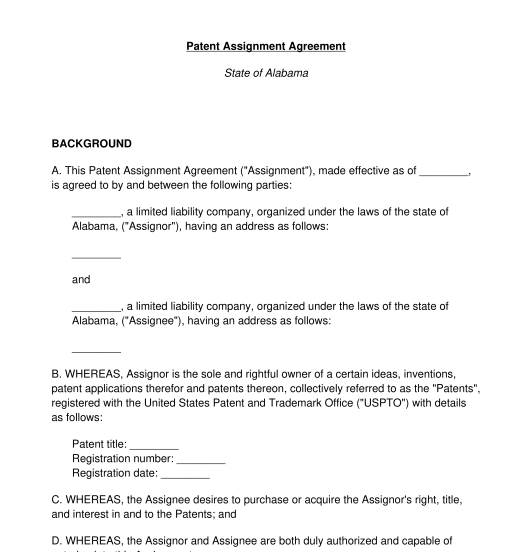
How does it work?
1. choose this template.
Start by clicking on "Fill out the template"
2. Complete the document
Answer a few questions and your document is created automatically.
3. Save - Print
Your document is ready! You will receive it in Word and PDF formats. You will be able to modify it.
Patent Assignment Agreement
This Patent Assignment Agreement is a comprehensive document designed to facilitate the transfer of patent ownership from the original patent owner, known as the assignor, to another party, known as the assignee .
A patent is a legal grant issued by the United States Patent and Trademark Office (USPTO) to an inventor, providing exclusive rights to make, use, and sell their invention for a limited period , typically 20 years from the filing date. This protection is granted in exchange for the public disclosure of the invention. This system encourages innovation and lets inventors benefit from their creations for a specified period of time.
An assignment is the legal transfer of ownership or rights of a patent from one party (assignor) to another (assignee) . Using a Patent Assignment Agreement, the assignor forever relinquishes their rights to the patent, and the assignee assumes control and ownership of those rights for the duration of the patent.
This assignment can be made either before or after a patent application has been issued as a patent. By law, a patent is considered personal property and, so, can be sold or transferred in the same way one could sell a car or a piece of furniture. This document formally initiates the transfer process, providing clarity and protection for both parties involved. This agreement is particularly useful when inventors, companies, or individuals who wish to transfer their patent rights, whether for financial considerations, strategic partnerships, or other business transactions.
This document is different from a Trademark Assignment Agreement, which is used for the transfer of a different kind of intellectual property, known as a trademark. A trademark is usually a brand name or logo, unlike a patent, which is usually an invention of some sort. This is also slightly different from an Intellectual Property Release . Although that form could be used for a patent, it is generally used for copyrighted material, like works of art or pieces of music. In that case, payment is not made and, instead, the copyrighted works are simply "released," or given to another party. This document can also be distinguished from an Intellectual Property Permission Letter, as there, one party is writing to request permission to use the intellectual property of another. The Patent Assignment Agreement would then come after the letter, but the letter is not the formal legal document that initiates the transfer.
How to use this document
This document includes all the information necessary to transfer the ownership of a patent from one party to another. This document should be used when the transfer will be permanent, usually for a one-time fee , and no royalties will be due after the assignment. This document allows the parties to fill in details of the patent to be transferred, such as the patent name, original recordation number, and date the patent was initially issued . This ensures that everything needed for new recordation with the United States Patent and Trademark Office (USPTO) is present.
Once the document has been completed, both parties should sign the document in front of a notary and have the notary complete the notary page. The document must then be recorded with the USPTO within three months of its signing, or it becomes void. The current cost for filing an assignment with the USPTO is $40 per patent. The assignment can be filed either online or by mail.
Applicable law
In the United States, specific federal laws govern patent assignments, primarily under Title 35 of the United States Code , which pertains to the country's patent system. Section 261 of Title 35 outlines the general provisions related to patent ownership and transfers. According to this statute, patent assignments must be in writing to be valid, and they require the signature of the owner of the patent or their authorized representative. The law also specifies that the assignment must be recorded with the USPTO to establish priority and provide notice to the public.
How to modify the template
You fill out a form. The document is created before your eyes as you respond to the questions.
At the end, you receive it in Word and PDF formats. You can modify it and reuse it.
Other names for the document:
Patent Assignment Contract, Intellectual Property Transfer Agreement, Technology Rights Conveyance Agreement, Innovation Assignment and Transfer Accord, Assignation of Patent Rights Contract
Country: United States
Intellectual Property and New Technologies - Other downloadable templates of legal documents
- Terms and Conditions for a Website
- Non-Disclosure Agreement (NDA)
- Privacy Policy For Website Or Mobile App
- Copyright Assignment
- Intellectual Property Permission Letter
- Intellectual Property Release Form
- Intellectual Property Cease and Desist Letter
- Model Release Form
- Personal Data Deletion Request
- Licensing Agreement
- Influencer Agreement
- Online Advertising Agreement
- Online Sponsorship Agreement
- Website or Mobile Disclaimer
- Media Release Agreement
- Graphic Design Agreement
- Affiliate Agreement
- Refund Policy
- Testimonial Release
- Copywriting Agreement
- Other downloadable templates of legal documents
FREE 9+ Patent Assignment Samples and Templates in PDF

A patent assignment is being able to legally transfer an owner’s property rights that are under a certain patent or certain patents, and any applications for said patent. Once the transfer is deemed as successful, this means that the assignee will now receive all of the owner’s interest and will now have the exclusive rights to the intellectual properties.
Patent Assignment
11+ assignment schedule samples and templates, 9+ sample assignment of mortgage template, 9+ sample assignment letter.
- Assignment Agreement Templates
- Patent License Agreement Samples and Templates
If you are looking for quick information about patent assignment, we are here for you! We also have a couple of sample patent assignments that can help you have a better insight as to what you need to fill out when it comes to applying for patent assignments. Once you are ready to find out more, just make sure that you keep scrolling! You may also see assignment letters .
Sample Annotated Patent Assignment
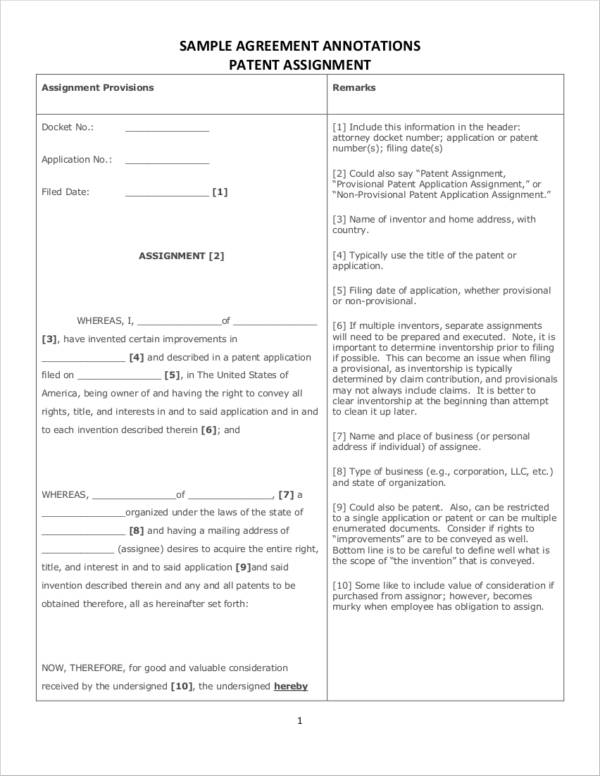
Size: 410 KB
Assignment of Patent Rights Sample
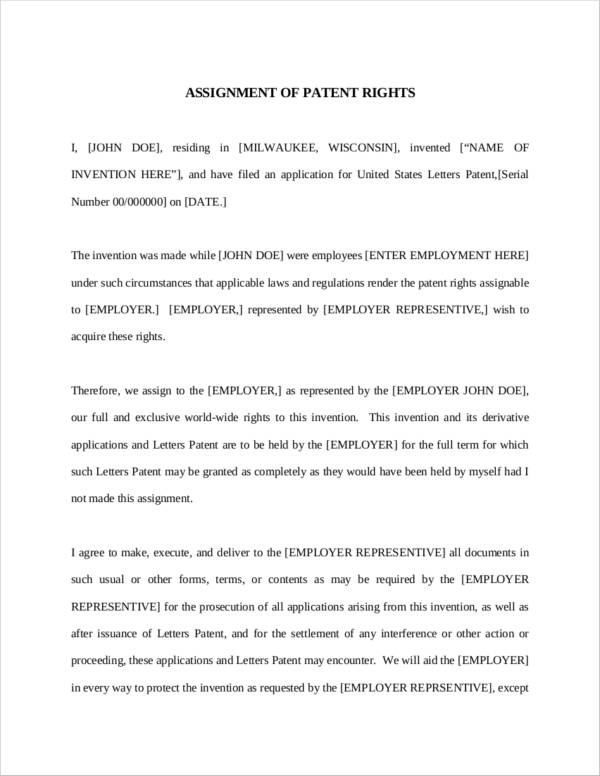
What Is a Patent Assignment?
There are actually four types of patent assignments:

1. Assignment of Rights
Patent Issued or patents that are considered to be already issued. You may also see assignment of mortgage templates .
2. Assignment of Rights
Patent Application or patents that are still in the application process.
3. Assignment of Intellectual Property Rights
No Patent Issued or inventions that are yet to be registered without any patent.
4. Exclusive Rights
The power that is granted to an assignee in order to prevent others or try to prevent others from distributing or selling inventions with patents without any permission from the patent owner. You may also check out assignment of lease templates .
Blank Patent Assignment in PDF
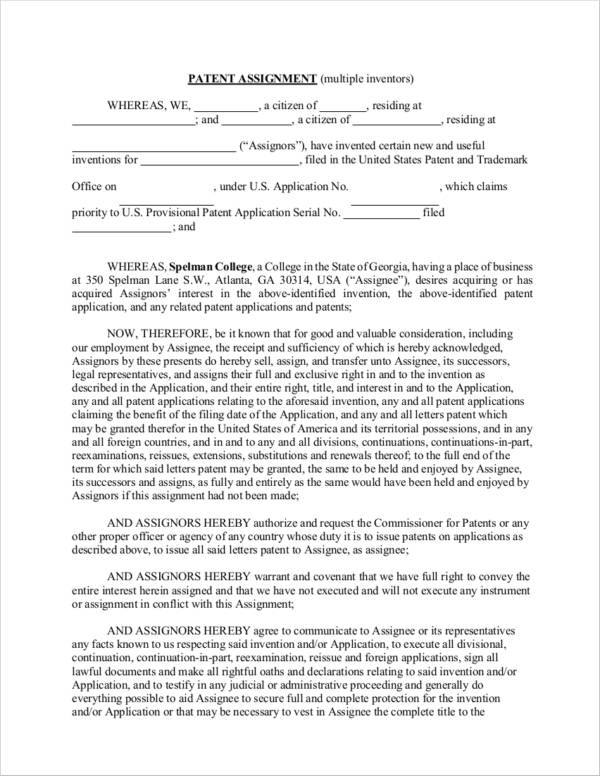
Size: 83 KB
Assignment of Application for Letters Patent Form
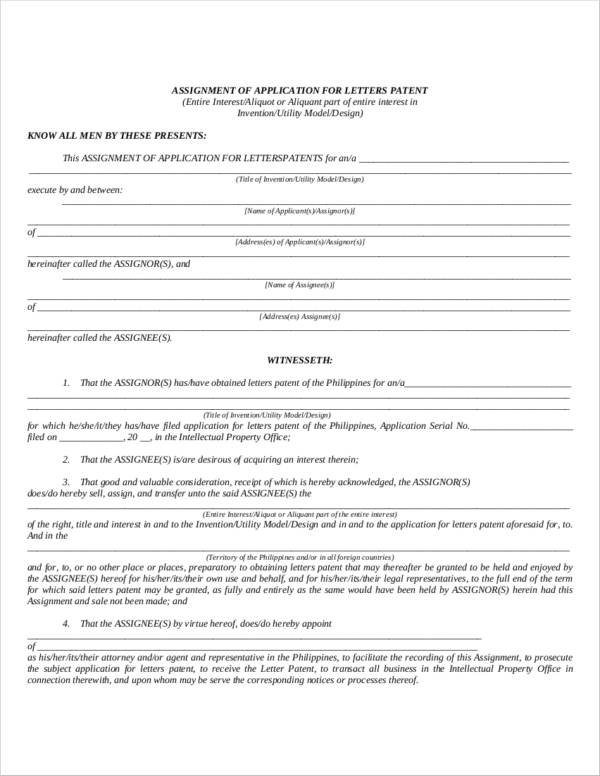
Size: 14 KB
Patent Assignment Application Form
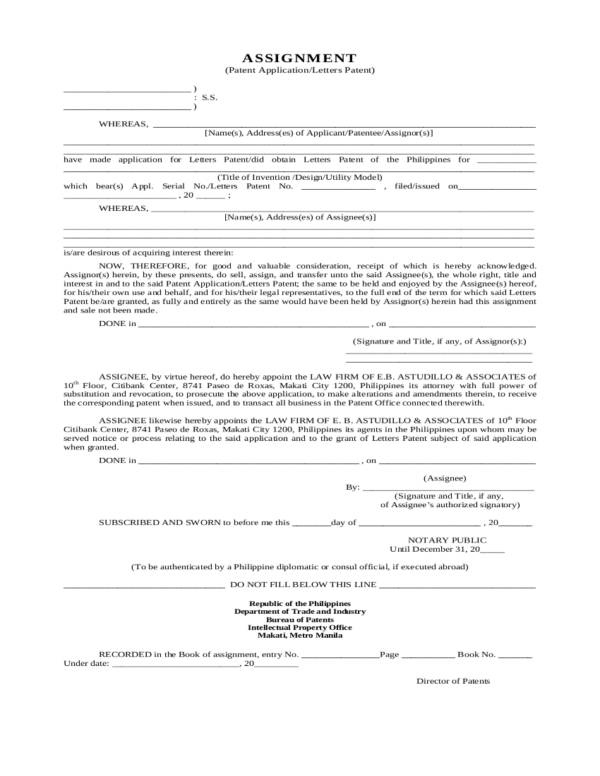
Size: 13 KB
The Advantages and Disadvantages of Patent Assignment
1. advantages.
Assignees do not make the inventions on their own. Plus, going through the whole patent application process can be such a lengthy one. They just really want to assume the exclusive rights to the intellectual property. So what is the biggest advantage that assignees get from a patent assignment? The potential profit that they will get. You may also see assignment of contract templates .
Intellectual property owners earn from their intellectual property as a ton of patents allow owners to earn from their inventions. Once the patent has been transferred, the assignee can start earning a portion of the profits from the patent. This means that both the patent owner and the assignee will benefit from this arrangement. You may also like assignment schedule samples and templates .
2. Disadvantages
If there are advantages to a patent assignment, there are also a couple of disadvantages to it. Some of the disadvantages are the following:
- There are too many inventors or the opposite. Patents can have more than one owner of the product or design made. There are times where a patent may have too many owners or too little owners. Should this be the case, incorrect filing may be argued and this can actually make the assignment of the patent not possible at all. You may also check out assignment sheet templates .
- Limited recourse. Some older patents may have already been under a couple of infringements. There are a limited number of patent assignments that may sue for any infringements that were encountered in the past or it is also known as the right to causes of action. This can actually cost the person assigned to the intellectual property potential profit, which can be a big loss. You might be interested in deed of assignment samples .
You can find out more about patent assignment by reading up on Assignment of Intellectual Property Rights .
Patent Assignment Guideline
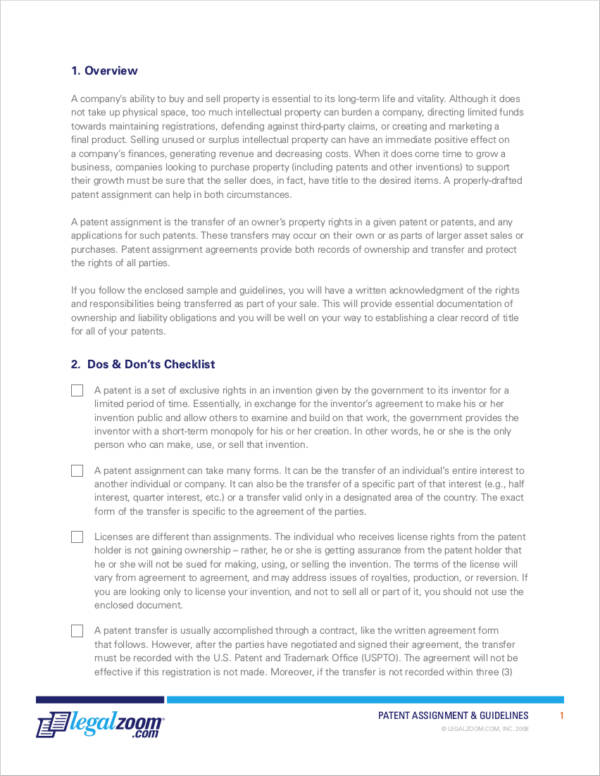
Size: 275 KB
Patent Assignment Agreement Sample
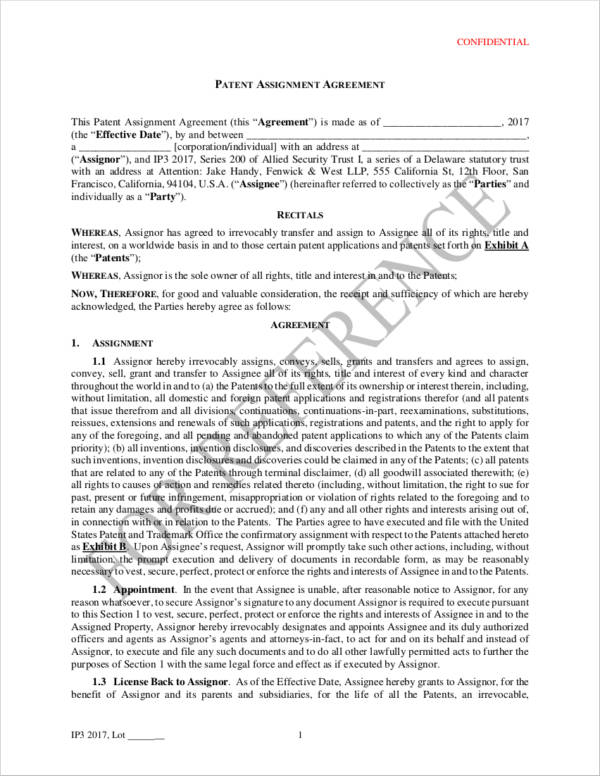
Size: 368 KB
Applying for Patent Assignments
The very first thing that you should do would be to fill out a form that is specific for patent assignment. This usually called a Patent Assignment Recordation Coversheet. This form can usually be found online. Should it not be available in your location, you may check out Patent Assignment Forms that we have right here to ensure that you have your own patent assignment form. However, to ensure that you have everything covered, you may want to have an attorney check out the form.
How Long Will Patent Assignment Applications Take?
Getting a patent is not going to be an easy process as it can be a lengthy one. According to the USPTO, patents can take up to three years before they get approved. The fastest means of making money from your invention can be through selling the patent for the invention that you have made and applying for the assignment. This way, you can easily see returns from the creation that you made. You may also see legal letter format samples .
You have to take note though that even if you will assign the patent to an assignee, it does not guarantee that you will get the patent in a faster manner. However, it will help to protect you and the assignee regarding the ownership and the rights of the invention. Patents will help to make you receive a lump sum price during the time the assignment was filed instead of collecting royalties from the invention. You may also like sample legal forms .
Once the invention or creation has been already patented, you are sure that you and the assignee will benefit from the patent and that it belongs to you and the assignee alone.
More information about buying and selling of intellectual property by checking out the article we have about Guide for Buying and Selling Intellectual Property .
Deed of Patent Assignment of Intellectual Property
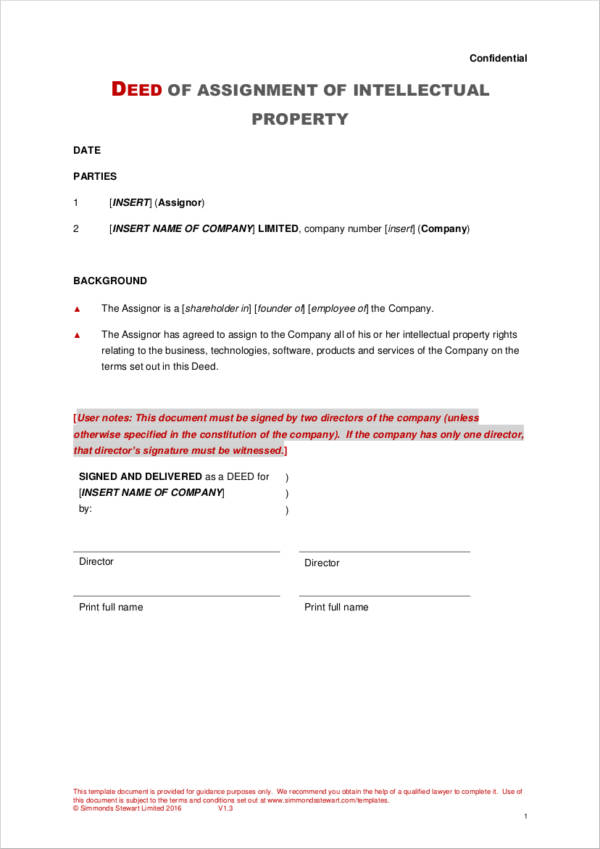
Size: 221 KB
Confidentiality and IP Patent Assignment Example
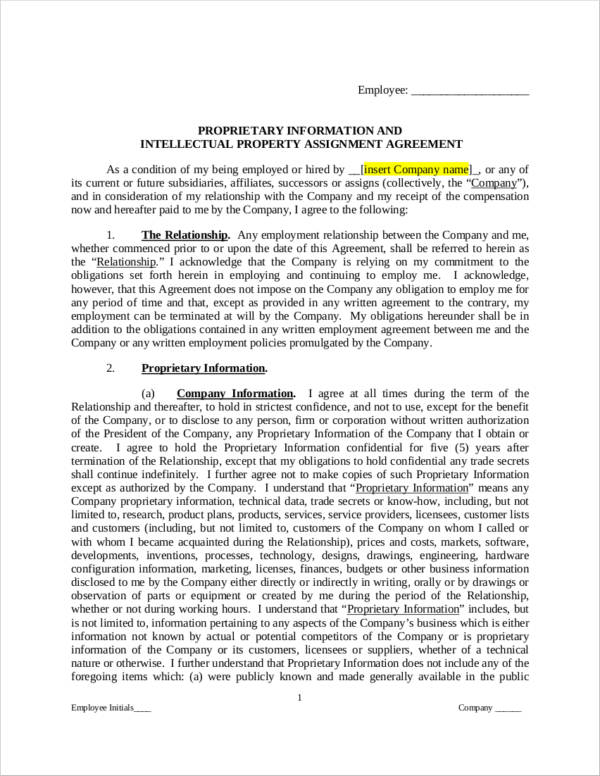
Size: 26 KB
Patent Assignment of Intellectual Property

Size: 88 KB
Common Mistakes Regarding Patent Assignments
1. failing to file the assignment document..
Do not rely on verbal agreements alone. Filing the transfer or assignment of the patent will help to leave a good paper trail regarding the patent assignment. Aside from the forms in this article, you may also check out Sample Assignment Letter if you want to make use of letters.
2. Actions before successful assignment.
The assignee should make sure that he/she should not sell the invention even before the patent has been successfully assigned to the assignee. This can lead to patent infringement.
3. Filing errors.
Patent assignments are considered to be legal and official documents. So you want to make sure that everything has been carefully reviewed before the submission of all the requirements. Make sure that the name of the assignee has been spelled out right. You should also make sure that all the owners of the patent are listed down in the patent assignment. You may also see what constitutes a legal contract?
4. Failure to properly identify the patent.
You want to make sure that all the information about your patent should be included in the patent assignment document. The patent number and all of the patent information should be included in the application forms or application letters.
5. Failure to check security interests.
You want to make sure that you are able to check for any security interests that might be present as patents can actually be used as collateral.
6. Failure to getting the application notarized.
You want to make sure that all the documents that you will be submitting for the patent assignment have been duly notarized by a notary public. It gives your patent assignment a huge advantage regarding the legality of the transaction. If you cannot get your documents notarized, make sure to have at least two witnesses to sign your documents. You may also like legal memo format samples .
Steps for Filing a Patent Assignment
1. Fill out an application form for the patent assignment. This is where you will state the name of the owner(s) and the name of the assignee(s). You will also be asked to state the patent number and the patent title.
2. Secure a patent assignment agreement. This document will state that the owner will be assigning the patent to the assignee. The intellectual property should also be properly described in this document. Provisions, as well as the terms and conditions, should be stated in this document with regards to the transaction. Check out Free Sample Agreements for more information about how you can come up with your very own agreement and the boilerplate that you should include in your agreement. Do not forget to have the owner(s) and assignee(s) sign the agreement to indicate that all parties involved agree to what is stipulated in the agreement.
- Take note that even if you are assigning the patent to a family member or a close friend, having a patent agreement will help to ensure that you and the assignee will be protected from a breach.
- In case you experience a breach, you may take a look at our article on Remedies for Contract Breaches to have a good idea on what you can do.
3. Submit the general application form and the other requirements that you might be asked to provide to ensure the success of patent assignment.
There you go! Now you have a better idea about how you can assign your patent to someone else. Do not hesitate to ask for help from someone who has experience with patent assignments or from attorneys to ensure that you’ve got everything covered. You may also check out legal invoice template.
Related Posts
Free 6+ special power of attorney samples in pdf, free 5+ business power of attorney samples in pdf, free 10+ health care power of attorney samples in pdf | ms word | google docs, free 6+ company power of attorney samples in pdf, free 5+ affidavit of desistance samples [ case, settlement, claim ], free 10+ affidavit of funeral expenses samples [ claim, cost, benefits ], free 6+ affidavit of translation samples in pdf, free 2+ supporting deposition samples in pdf | ms word, free 9+ affidavit samples in pdf | ms word, free 9+ sample orders to appear in pdf, free 5+ mortgage deed samples & templates in pdf, free 13+ general power of attorney templates in pdf | ms word, free 19+ general affidavit samples and templates in pdf, free 14+ deed of discharge samples & templates in pdf | ms word, free buying & selling intellectual property [ definition, types, facts ], 9+ sample novation agreement, 9+ sample cover sheet template, 9+ sample college ruled paper template, 9+ sample homework calendar.
Try our Advanced Search for more refined results
The Practice of Law
- Law360 Pulse
Business of Law
Law360 authority, deep news & analysis, tax authority, employment authority, insurance authority, real estate authority, bankruptcy authority, healthcare authority.
- Law360 Employment Authority
- Law360 Tax Authority
- Law360 Insurance Authority
- Law360 Real Estate Authority
- Law360 Healthcare Authority
- Law360 Bankruptcy Authority
- Law360 In-Depth
- Law360 Podcasts
- Regional Powerhouses
- Law360's MVPs
- Women in Law Report
- Diversity Snapshot
- Practice Groups of the Year
- Rising Stars
- Titans of the Plaintiffs Bar
- Adv. Search & Platform Tools
- About all sections
- Browse all sections
- Class Action
- Competition
- Expert Analysis
- Intellectual Property
- Product Liability
- Track attorneys
- Track judges
- Join the Law360 team
- Search legal jobs
- Learn more about Law360
- Read testimonials
- Contact Law360
- Sign up for our newsletters
- Law360 Company
- About Law360 Authority
- Resource Library
WDTX Chief Adds New Hurdle For Patent Attys Eyeing Albright
Law360 is on it, so you are, too..
A Law360 subscription puts you at the center of fast-moving legal issues, trends and developments so you can act with speed and confidence. Over 200 articles are published daily across more than 60 topics, industries, practice areas and jurisdictions.
A Law360 subscription includes features such as
- Daily newsletters
- Expert analysis
- Advanced search
- Judge information
- Real-time alerts
- 450K+ searchable archived articles
Experience Law360 today with a free 7-day trial.
Already a subscriber? Click here to login
Attached Documents
- Patent Order
- Assignment Order
Related Sections
- Legal Industry
Judge Analytics
powered by Lex Machina®
- I forgot my password
- I took a free trial but didn't get a verification email
- How do I sign up for a newsletter?
Already have access? Click here to login
Get instant access to the one-stop news source for business lawyers, sign up now for free access to this content.
Email (NOTE: Free email domains not supported)
PLEASE NOTE: A verification email will be sent to your address before you can access your trial.
Password (at least 8 characters required)
Confirm Password
Show all interests
Law360 may contact you in your professional capacity with information about our other products, services and events that we believe may be of interest. You’ll be able to update your communication preferences via the unsubscribe link provided within our communications. We take your privacy seriously. Please see our Privacy Policy .
Already have access?
- Password: Forgot your password?
- Remember login
Sign up for our Intellectual Property newsletter
You must correct or enter the following before you can sign up:.
Law360 takes your privacy seriously. Please see our Privacy Policy .

An official website of the United States government Here’s how you know keyboard_arrow_down
An official website of the United States government
The .gov means it’s official. Federal government websites often end in .gov or .mil. Before sharing sensitive information, make sure you’re on a federal government site.
The site is secure. The https:// ensures that you are connecting to the official website and that any information you provide is encrypted and transmitted securely.
Jump to main content

In response to public feedback regarding the retirement of the legacy search systems, a new simplified interface of Patent Public Search named Basic Search is now available. Basic Search is recommended for users new to Patent Public Search, or for users who only need to perform a quick look up.
PatFT, AppFT, PubEAST and PubWEST were retired on September 30. Preexisting links to U.S. patents and pre-grant publications are no longer available. You will need to create new links for saved documents. Read through this step-by-step guide on how to set up a web link to access a saved document, as well as set up saved search queries. For questions regarding Patent Public Search, please contact the Public Search Facility at [email protected] .
Search for patents
New to Patent Searching? See this important information about searching for patents:
How to Conduct a Preliminary U.S. Patent Search: A Step by Step Strategy - Web Based Tutorial (38 minutes)
- The Multi-Step strategy - A handout that outlines a suggested procedure for patent searching
Patents may be searched using the following resources:
Patent Public Search
The Patent Public Search tool is a new web-based patent search application that replaced internal legacy search tools PubEast and PubWest and external legacy search tools PatFT and AppFT. Patent Public Search has two user selectable modern interfaces that provide enhanced access to prior art. The new, powerful, and flexible capabilities of the application improves the overall patent searching process.
Global Dossier
Global Dossier is a set of business services aimed at modernizing the global patent system and delivering benefits to all stakeholders through a single portal/user interface . Through this secure service, users have access to the file histories of related applications from participating IP Offices, which currently include the IP5 Offices.
By using this service, users can see the patent family for a specific application, containing all related applications filed at participating IP Offices, along with the dossier, classification, and citation data for these applications. This service also provides Office Action Indicators to help users identify applications that contain office actions, a Collections View for saving documents and applications for review later on in the session, and the ability to download the documents in an application.
Public Search Facility
The United States Patent and Trademark Office (USPTO) Public Search Facility located in Alexandria, VA provides the public access to patent and trademark information in a variety of formats including on-line, microfilm, and print. Trained staff are available to assist public users.
Patent and Trademark Resource Centers (PTRCs)
Your nearest Patent and Trademark Resource Center (PTRC) maintains local search resources and may offer training in patent search techniques.
- Find your nearest PTRC
Patent Official Gazette
The Electronic Official Gazette allows users to browse through the issued patents for the current week. The Official Gazette can be browsed by classification or type of patent, for example, utility, design, and plant.
Common Citation Document (CCD)
The Common Citation Document (CCD) application aims to provide single point access to up-to-date citation data relating to the patent applications of the IP5 Offices. It consolidates the prior art cited by all participating offices for the family members of a patent application, thus enabling the search results for the same invention produced by several offices to be visualized on a single page. The creation of the CCD application is part of an ongoing process of technical harmonization at international level aimed at establishing an appropriate infrastructure to facilitate greater integration of the global patent system.
Search International Patent Offices
To see if your idea has been patented abroad, you'll want to refer to searchable databases made available from other International Intellectual Property offices. Free online access to patent collections is provided by many countries. Some available databases include:
- European Patent Office (EPO) provides esp@cenet a network of Europe's patent databases- This site also provides access to machine translation of European patents for some languages.
- Japan Patent Office (JPO) - This site also provides access to machine translations of Japanese patents.
- World Intellectual Property Organization (WIPO) provides PATENTSCOPE ® Search Service, which features a full-text search of published international patent applications and machine translations for some documents as well as a list of international patent databases.
- Korean Intellectual Property Rights Information Service (KIPRIS)
- China National Intellectual Property Administration (CNIPA) - This site also provides access to machine translation of Chinese patents.
- Other International Intellectual Property Offices that provide searchable patent databases include: Australia , Canada , Denmark , Finland , France , Germany , Great Britain , India , Israel , Netherlands , Norway , Sweden , Switzerland and Taiwan .
Stopfakes.Gov provides informative Toolkits that give an overview of the Intellectual Property Rights (IPR) environment in various countries around the world.
For additional search resources, contact your local Patent and Trademark Resource Center , visit the USPTO Public Search Facility or the USPTO Main STIC Library . The staff in the Main STIC Library are experts on foreign patents and able to help the public as needed.
Search Published Sequences
The Publication Site for Issued and Published Sequences (PSIPS) website provides Sequence Listings, tables, and other mega items for granted US patents or published US patent applications.
All sequences (SEQ ID NOs.) and tables for listed patents or publications are available for viewing, without downloading, by accessing the proper document detail page and then submitting a SEQ ID NO or a mega table ID number.
Patent Assignment Search
Visit the Patent Assignment Search website to search for patent assignments and changes in ownership.
Patent Examination Data System (PEDS)
The Patent Examination Data System (PEDS) in the Amazon Cloud provides public users the ability to search, view and download bibliographic data for all publicly available Patent applications in a secure manner. The solution allows public users to search and download bibliographic data in bulk as well as manage the volume of data that can be downloaded at any given period of time by a particular user.
Additional information about this page

IMAGES
VIDEO
COMMENTS
What you need to know, before filing (PDF) Sample of a Patent Assignment (PDF) Sample of a Trademark Assignment (PDF) Resources. Upload a Document (PDF) Trademark Assignment Fees (Fee codes: 8521 and 8522) Manual of Patent Examining Procedure (MPEP) Trademark Manual of Examining Procedures (TMEP) Assignment Search ; Tutorial
ASSIGNMENT OF PATENT Hereafter referred to as said assignee is desirous of acquiring the entire right and interest in said patent/application. ... by these presents do sell, assign and transfer unto said assignee the entire right title and interest in aforesaid patent to the full end of the term for which said Patents is granted. Whereas, (Name ...
A patent assignment is the transfer of an owner's property rights in a given patent or patents, and any applications for such patents. These transfers may occur on their own or as parts of larger asset sales or purchases. Patent assignment agreements provide both records of ownership and transfer and protect the rights of all parties.
Select one. Enter name or number. This searchable database contains all recorded Patent Assignment information from August 1980 to the present. When the USPTO receives relevant information for its assignment database, the USPTO puts the information in the public record and does not verify the validity of the information.
This patent assignment is between , an individual a(n) (the "Assignor") and , an individual a(n) (the "Assignee"). The Assignor has full right and title to the patents and patent applications listed in Exhibit A (collectively, the "Patents").. The Assignor wishes to transfer to the Assignee, and the Assignee wishes to purchase and receive from the Assignor, all of its interest in the Patents.
On June 29, 2021, in Hologic v. Minerva Surgical, 141 S.Ct. 1068, the Supreme Court ruled on a case addressing assignor estoppel. Assignor estoppel is a doctrine that broadly holds that a party that has assigned a patent cannot later challenge the validity of that patent's claims. In Hologic, an assignee added an allegedly broader claim ...
Patent Assignment Agreement. Last revision 02/10/2024. Formats Word and PDF. Size 5 to 6 pages. Fill out the template. This Patent Assignment Agreement is a comprehensive document designed to facilitate the transfer of patent ownership from the original patent owner, known as the assignor, to another party, known as the assignee.
PATENT ASSIGNMENT (multiple inventors) WHEREAS, WE, ; and , a citizen of , a citizen of , residing at , residing at inventions for ("Assignors"), have invented certain new and useful , filed in the United States Patent and Trademark Office on , under U.S. Application No. , which claims priority to U.S. Provisional Patent Application Serial ...
PCT Applications and Assignment Issues - Example Example - you file a priority application (e.g., a PRV), and get a fully executed assignment for the priority application; the assignment including specific language that assigns the right to claim priority to the priority application in one or more subsequently filed applications.
What do I need to know about assignments? What you need to know, before filing (PDF) Sample of a Patent Assignment (PDF) Sample of a Trademark Assignment (PDF) Resources. Upload a Document (PDF) Trademark Assignment Fees (Fee codes: 8521 and 8522) Manual of Patent Examining Procedure (MPEP) Trademark Manual of Examining Procedures (TMEP)
Intellectual Property Agreement (IPA) assignment. ASSIGNMENTS "Assignment", in general, is the act of transferring the title, ownership, and rights of one's property to another. Intellectual property (such as inventions and patents) , is an intangible type of personal property, and under patent law, patent applications have the attributes ...
1. ASSIGNMENT. 1.1Assignor hereby irrevocably assigns, conveys, sells, grants and transfers and agrees to assign, convey, sell, grant and transfer to Assignee all of its rights, title and interest of every kind and character throughout the world in and to (a) the Patents to the full extent of its ownership or interest therein, including ...
LEARNING POINT 1: Basics of invention and patent. 1. One way of adding value to a product. In an increasingly knowledge‐driven economy, you invariably need creative or inventive ideas or concepts to improve an existing feature, add a useful new feature to your product or develop a totally new product. If your business develops such an idea or ...
323.01(c)-Assignment or Change of Name Improperly Filed and Recorded by Another Person Against Owner's Application or Patent 323.01(d)-Expungement of Assignment Records 324-Establishing Right of Assignee To Take Action in Application Filed Before September 16, 2012
There are actually four types of patent assignments: 1. Assignment of Rights. Patent Issued or patents that are considered to be already issued. You may also see assignment of mortgage templates. 2. Assignment of Rights. Patent Application or patents that are still in the application process. 3.
This Assignment is deemed to be executed and delivered within the State of Georgia, and it is the intention of the parties that it shall be construed, interpreted and applied in accordance with the laws of the State of Georgia without regard to its conflicts of law principles. [SIGNATURES ON FOLLOWING PAGE] (SIGNATURE PAGE TO PATENT ASSIGNMENT)
Section 2. Assignment. 2.1 Assignor shall transfer and assign to Assignee all of Assignor s right, title and interest to any and all patent ownership interest Assignor may have throughout the world in and to the Assigned Patents as of the Closing Date. 2.2 Assignee shall be solely responsible for all actions and all costs whatsoever, including ...
By Dani Kass. Law360 (May 31, 2024, 4:49 PM EDT) -- The Western District of Texas' chief judge has made it harder for parties to have their patent cases end up in U.S. District Judge Alan Albright ...
Form PTO-1595 (Rev. 6-18) U.S. DEPARTMENT OF COMMERCE OMB No. 0651-0027 (exp. 06/30/2021) United States Patent and Trademark Office. To the Director of the U.S. Patent and Trademark Office: Please record the attached documents or the new address(es) below. 1.
Patent Public Search. The Patent Public Search tool is a new web-based patent search application that replaced internal legacy search tools PubEast and PubWest and external legacy search tools PatFT and AppFT. Patent Public Search has two user selectable modern interfaces that provide enhanced access to prior art. The new, powerful, and flexible capabilities of the application improves the ...